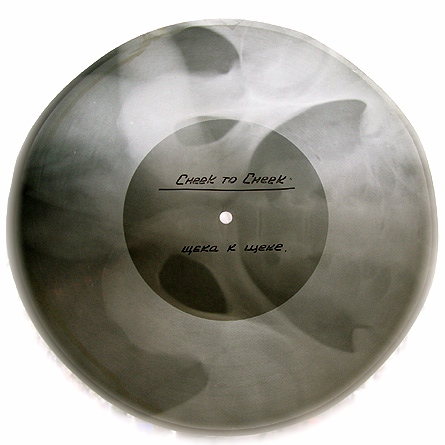
Bone Music: Soviet bootleg records on xrays – Bone Music: dischi bootleg sovietici sulle radiografie
UK/IT Version – Most Western music, such as jazz and rock-and-roll, was outlawed in the Soviet Union under the Zhdanov Doctrine of 1946, which regulated all intellectual activity, from literature to medicine to music. Records by the Beatles, Billie Holliday and Roy Orbison, for example, weren’t allowed through the Iron Curtain, since they didn’t adhere to Communist Party principles.
But a certain subculture of young people, the stilyagi, wanted to listen to rock-and-roll. So they figured out a way to get the music by making homemade records out of X-rays.
Some bootleg copies of records would inevitably find their way into the country, so the stilyagi often had a master disc. What they needed was a material to reprint it on, as vinyl wasn’t too common. They took to rummaging through hospital trash bins and digging out discarded X-rays. They then used a traditional wax disk cutter and a recording lathe to etch copies of the album onto the X-ray, which they cut it into a circle with scissors before burning a hole in the middle with a cigarette. Voilà: an album that could be played on a turntable.
“Usually it was the Western music they wanted to copy,” Sergei Khrushchev, the son of former Soviet premiere Nikita Khrushchev, told NPR. “Before the tape recorders they used the X-ray film of bones and recorded music on the bones, bone music.”

The practice quickly grew into an underground business run by black market record distributors called “roentgenizdat,” which translates into X-ray press. The groups distributed millions of records until the Soviet Union made the practice illegal in 1958.
“It was a bit like dealing or buying drugs, actually. These records were bought and sold on street corners, in dark alleyways, in the park,” says Stephen Coates, author of “X-Ray Audio: The Strange Story of Soviet Music on the Bone. These bone records served a purpose at the time, but since X-ray film is so thin, the sound quality of the records was terrible — and the albums themselves would eventually disintegrate under the turntable’s needle after a handful of plays. Some were virtually unlistenable. But that didn’t seem to matter, in some ways. I mean, talking to people who bought these records when they were young — even the tiniest thread of melody, of this forbidden sound, was so exciting.”
La maggior parte della musica occidentale, come il jazz e il rock-and-roll, è stata messa fuori legge in Unione Sovietica sotto la Dottrina Zhdanov del 1946, che regolava tutte le attività intellettuali, dalla letteratura alla medicina alla musica. I dischi dei Beatles, Billie Holliday e Roy Orbison, per esempio, non potevano attraversare la cortina di ferro, dal momento che non aderivano ai principi del Partito Comunista.
Ma una certa sottocultura di giovani,gli stilyagi, voleva ascoltare il rock and roll. Così hanno escogitato un modo per ottenere la musica realizzando dischi fatti in casa con i raggi X.
Alcune copie illegali di dischi finivano inevitabilmente per entrare nel paese, quindi gli stilyagi avevano spesso un master disc. Ciò di cui avevano bisogno era un materiale su cui ristamparlo, dato che il vinile non era molto comune. Hanno iniziato a frugare nei bidoni della spazzatura dell’ospedale e a estrarre i raggi X scartati. Hanno quindi utilizzato un tornio di registrazione per incidere copie dell’album sulla radiografia, che hanno tagliato in un cerchio con le forbici prima di bruciare un buco nel mezzo con una sigaretta. Voilà: un album che potrebbe essere suonato su un giradischi.

“Di solito era la musica occidentale che volevano copiare”, ha detto a NPR Sergei Khrushchev, figlio dell’ex premier sovietico Nikita Khrushchev . “Prima dei registratori a nastro usavano la pellicola a raggi X delle ossa e registravano musica sulle ossa, musica ossea”.
La pratica è rapidamente diventata un’attività clandestina gestita da distributori di dischi del mercato nero chiamati “roentgenizdat”, che si traduce in stampa a raggi X. I gruppi hanno distribuito milioni di dischi fino a quando l’Unione Sovietica non ha reso illegale la pratica nel 1958.
“In realtà era un po’ come spacciare o comprare droga. Questi dischi sono stati acquistati e venduti agli angoli delle strade, nei vicoli bui, nel parco”, ha detto Stephen Coates, autore di “X-Ray Audio: The Strange Story of Soviet Music on the Bone. Questi dischi ossei avevano uno scopo all’epoca, ma poiché la pellicola a raggi X è così sottile, la qualità del suono dei dischi era terribile e gli album stessi alla fine si sarebbero disintegrati sotto la puntina del giradischi dopo una manciata di ascolti. Alcuni erano praticamente inascoltabili. Ma questo non sembrava avere importanza, per certi versi. Raccontano le persone che hanno comprato questi dischi quando erano giovani che ascoltare anche il più piccolo filo di melodia di questo suono proibito era veramente eccitante”.



No Comments